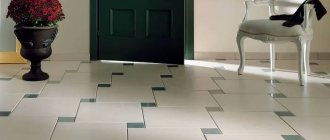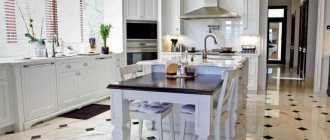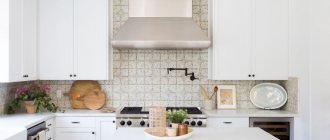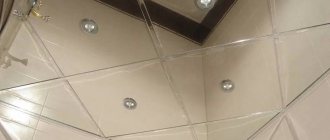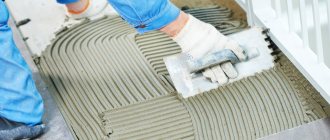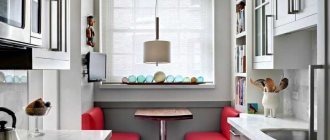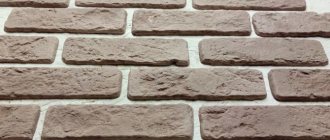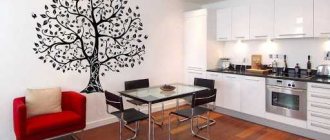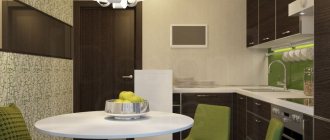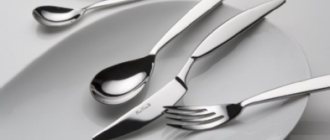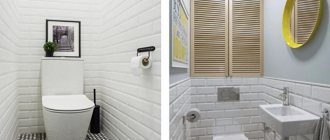Before you start finishing the walls in the kitchen, you need to think about what material it will be made of, because it is important that it is resistant to moisture, steam, grease, detergents and cleaning products.
For these purposes, it is necessary to choose a material that can retain its decorative properties and functions for a long time. Perhaps the most common option for wall decoration in the kitchen is ceramic tiles.
Tile is considered the most suitable material because it is easy to clean, wear-resistant and environmentally friendly.
In addition, it does not collapse under high mechanical loads and has excellent properties during operation.
Durable and rigid material, which is also very aesthetically pleasing. The tiles can be used on any surface, and the walls do not require additional processing other than leveling and tile adhesive.
Benefits of using tiles
Among the advantages of choosing a material, the following points should be noted:
- Strength of the material.
- Easy to install tiles. You can start working on your own with only minor construction skills.
- Fungus does not form under the tiles (if the installation rules are followed).
- Tiles allow you to hide defects and irregularities on the walls.
- A wide range of models of all colors, sizes and textures.
- The tiles are resistant to moisture, so wet cleaning is not difficult for the housewife.
A wide price range can also be considered a plus, because this parameter is often the main one for buyers.
Options for modern floor design/Flooring design for the kitchen (photo selection)
If you choose the right kitchen tiles, they will last a long time. Let's consider the main criteria by which you need to choose tiles for the floor.
Durability is one of the main advantages of using tiles for flooring
Dimensions
Sizes may vary, but optimal for a kitchen is at least 6 sq.m. 15*15 and 30*30 options are considered. For larger rooms it is better to buy 40*40, 50*50 or 60*60. The thickness of the tiles should be from 8 to 12 mm. This guarantees long-term operation and resistance to wear.
By laying tiles of different sizes, the kitchen can be divided into functional zones
Form
This parameter depends on the layout method. The shape of the tile is:
- square - laid in the classical way;
- rectangular - laid “in a bandage”, “zigzag” or “under the parquet”;
- hexagonal - stacked in the form of a honeycomb;
- octagonal - laid in combination with square tiles that fill the gaps.
Using tiles of the same shape, but with different patterns, you can create an original flooring design
Color, thickness and color of seams
Proper selection will visually increase the space. Let's look at some important aspects:
- It is desirable that the floor tiles be darker than the wall tiles;
- you can choose materials that will imitate wood, fabric, stone or metal;
- simple patterns visually enlarge the room, while complex patterns narrow the space;
- the thickness of the joints can be different, the color of the joints is more important - if the grout is contrasting, then the room will be visually smaller, if the grout is darker than the tiles, then the floor will visually look cleaner, but a light grout will create the opposite effect;
- Rectified porcelain tiles can be laid without seams.
Floor tiles can match the furniture or contrast
Wear resistance
The areas under the highest load are near the stove, sink and at the entrance to the kitchen. To prevent the tile from losing its original appearance over time, it is necessary to choose tiles of the appropriate class.
Only strong tiles are suitable for kitchen flooring, as they will bear a lot of weight.
The American classification distinguishes five classes:
- PEI I for wall cladding;
- PEI II for wall and floor cladding in the bedroom, living room, office;
- PEI III for flooring in any rooms of residential premises.
- PEI IV and PEI V for any premises.
Safety
The tiles should not be slippery. The degree of slip can be understood by a certain parameter called the “friction coefficient”. It is indicated on the packaging. According to the standards, there are 4 categories of tiles; the closer the indicator is to one, the less slippery the tile is.
To prevent splashes of water near the sink from resulting in injuries, the tiles should be non-slippery
Frost resistance
This indicator is important if the kitchen is located in a house or country house where residents do not live all year round. The parameter depends on moisture absorption. For ceramics, moisture absorption should be no more than 3%, and for porcelain stoneware no more than 0.05%.
For the kitchen, it is better to choose tiles with a matte surface, on which scratches and abrasions are less visible.
Variety
Tiles come in three grades: 1,2,3. This indicator indicates how many defective tiles are allowed per 100 pieces.
- Grade 1 – red marking (5% defect allowed).
- 2nd grade – blue marking (up to 25%).
- Grade 3 – green marking (approximately 50%).
Defects do not mean broken tiles or chips on them. These may be minor scratches, roughness or any inclusions
Disadvantages of Practical Choices
However, using ceramic tiles also has its disadvantages:
- When purchasing ceramics with a plot pattern, the master must follow the sequence of laying the modules.
- The need to cut tiles to lay difficult places.
- Finishing wall panels requires a large amount of consumables.
- When using mosaic tiles, large gaps are formed between adjacent elements in which dirt can accumulate.
For some types of ceramics, preliminary preparation of the walls is necessary (primer, putty, leveling).
Varieties
- pressed: made from a mixture of clay and sand by pressing
- extruded: made from a dough-like mass (15-20% water) passed through the opening of an extruder. It has different shapes and sizes.
In appearance it happens:
- glazed: has a thin top coating of glass
- unglazed: without spraying, optimal floor covering
Choice of colors
The design of kitchen wall tiles is an important parameter that should be approached with special care. It has long been known that the optimal color combination can create the desired visual effect.
The choice of color depends on the personal wishes of the owner, the chosen interior style, and the size of the kitchen space. Possible options:
- Light shades are perfect for small spaces and combined rooms (for example, studio apartments). These can be cream, pale blue tones.
- Dark tones (black, dark brown shades) are used as a contrasting color (for example, to visually highlight a white set).
Also a common option is the use of mosaic tiles or tiles with a stencil pattern. Such models are successfully combined with modern interior styles - Loft, minimalism and eco-style.
Expert advice
Tiles are a very durable material, and the costs of purchasing and installing them are quite high, so before purchasing the material it is better to take the advice of experienced finishers:
- It is necessary to buy tiles only after the kitchen design has been fully thought out and its color scheme has been determined. The material can complement other decoration or furnishings, match tone-on-tone or contrast with them.
- You shouldn’t trust even professional calculations too much. During the renovation, something will definitely go wrong (the tile will break, a piece will fall off, it will be cut incorrectly), so a small supply of tiles (10-15% of the total need) will definitely find its use.
On the other hand, online store calculators can produce an error in the other direction, providing customers with excess meters of goods offered. In this case, the store has every right not to accept back material that is not needed.
- The tiles must be checked before paying. There are cases when a perfectly flat package contains tiles with chipped edges.
- The size of the tile also plays an important role. Small tiles will avoid a lot of waste, but will create too many joints, and a room decorated with small objects will look too difficult to perceive. Large tiles (especially with a pattern) will visually reduce the space and will not be an effective way to save: some of the rectangles will have to be cut, and using small pieces will be quite problematic.
Relief tiles will more readily collect dirt and carbon deposits, and will be more difficult to clean. Therefore, it is better to stick to smooth materials.
Glossy tiles will bring more light into the kitchen, but water droplets and stains are clearly visible on them. Accordingly, you will have to wash it more often. Matte tiles will be a more pleasant finish in this regard.
Methods for attaching tiles to the wall
The quality of laying tiles on the kitchen wall largely depends on the technique used and the method of fastening. The following fastening methods are known today:
Cement mortar. The most reliable type of installation. Used for problem walls, in places where dampness and moisture accumulate. For optimal installation, the correct ratio of sand, cement and water is required, as well as the use of a special mesh for ceramic elements.
Use of special glue. Each type of tile requires the selection of the optimal adhesive solution to ensure reliable and durable fastening of the material.
To prevent the formation of gaps between adjacent elements, putty or plastic layers are used between the tiles. Instructions on how to glue tiles to a wall in the kitchen can be found on any web resource for practical repairs.
Marking
Having decided on the materials and adhesive mixtures, you can begin marking the room. But first you need to determine how to lay floor tiles in order to accurately calculate the required quantity.
The easiest option is to first draw everything on a piece of paper. It is best to use a computer layout program. Now there are many of them.
After purchase, it is recommended to lay at least part of the tiles “dry” on the floor and visually look at the result. You may need to adjust (move in one direction or another) the location.
Important! The tile is highly durable, but at the same time fragile. Therefore, it is recommended to buy it with a margin of 10-15%.
Types of tiles for the kitchen
Manufacturers of construction and finishing materials today can offer their customers a huge range of products. The most interesting types of ceramic tiles for the kitchen wall:
- Pressed tiles.
- Model without enamel.
- Glazed tiles.
- Clinker model.
All presented options differ in a set of positive and negative properties that determine the buyer’s choice.
Note!
- Linoleum for the kitchen - master classes on installing linoleum in the kitchen interior. The best design ideas and color schemes (120 photos)
- Illumination of the work area in the kitchen: TOP-130 design options. Rules for selecting and installing lighting in photo reviews
- Stretch ceiling in the kitchen - TOP-130 design options for stretch ceiling in the kitchen + photo examples
Tools
To lay tiles, regardless of the base, mixtures used to level the floor, methods, adhesive tile compositions and other components, you will need a certain set of tools. Here he is:
- Flute brushes and paint brushes - for cleaning the surface for laying. You can also use a construction vacuum cleaner;
- Paint roller – for priming the floor;
- Tape measure, square, ruler - measuring tools. Will be needed all the time until the end of the flooring;
- Hydraulic level, tapping cord - will serve at the stage of marking the surface for laying;
- Rule-trapezoid, level, nylon thread - necessary to create precise horizontal lines and prevent differences in floor level;
- A drill with a mixing attachment and a deep container - you cannot do without their help when preparing the adhesive mixture;
- Spatula, notched trowel, trowel - tools for applying diluted mortar to the surface of tiles and floors;
- A rubber hammer is a tool for shrinking the laid tiles;
- Tile cutter, tile cutter, grinder with a disk for dry cutting - specific tile tools for cutting tiles in straight lines;
- Tile nippers - will be needed in case of removing small pieces of tiles (in particular corners) of irregular geometric shape;
- Ballerina is a tool for drilling even round holes of various diameters.
- Grouting compounds
Glazed tiles
An excellent option for finishing the dining area. It has a stylish design and a pleasant glossy shine. Will highlight any interior style. The advantages of use include special strength, a smooth surface without a relief pattern.
The disadvantage is the high cost. Before carrying out repair work, you will need to carefully calculate consumables to avoid unnecessary financial expenses.
Ideas for decorating an apron (selection of photos)
A selection of photos and recommendations on what tiles should be on the kitchen work wall will help you make the right choice.
Kitchen apron made of laminated MDF and chipboard
This apron is an excellent solution - price equals quality. The apron is made from laminated MDF and chipboard in the same way as the tabletop itself. Its essence is that the wood adhesive material is laminated with plastic on all sides.
The features of this apron include:
- Easy to install and dismantle.
- Easy care.
- The apron can be made under the tabletop or under the facades of furniture.
- Price-quality ratio. And in terms of cost, it’s a small waste of money.
